Comparison of Methodologies for Microplastic Isolation through Multicriteria Analysis (AHP)
Abstract
1. Introduction
1.1. Environmental Impacts and Sources of MPs
1.2. EU Legislation and Initiatives on Plastic Waste
2. Materials and Methods
- Purity: CEN Standard sand is known for its high purity. Its composition is representative of a well-defined natural siliceous sand without additional contaminants, ensuring that the control sample is free from external influences that could affect the comparison.
- Isometric Rounded Grains: The sand grains in CEN Standard sand exhibit isometric rounded shapes. This characteristic contributes to the homogeneity of the control sample, providing a consistent and well-defined structure for evaluation across different methodologies.
- Certification (EN 196-1): CEN Standard sand is certified according to the EN 196-1 standard. This certification establishes a common denominator for the evaluation of the three methodologies under consideration. It ensures that the control sample adheres to specific quality and performance standards, enhancing the reliability and consistency of the comparison. By utilizing CEN Standard sand as the control sample, the study aims to establish a baseline that facilitates a meaningful and standardized comparison of the four methods. This approach ensures that any variations observed in the results can be attributed to the methodologies themselves rather than differences in the characteristics of the control sample. Table 1 showcases the grading size of CEN Standard Sand used to compare the four solutions.
2.1. Spiking and Recovery Test
2.1.1. Solutions of Sodium Chloride, Magnesium Sulfate, Sodium Hexametaphosphate
2.1.2. Canola Oil
2.2. Protocol Validation
- Use of Glass and Metal Equipment: Glass and metal equipment was exclusively utilized during sample processing and for experimental controls. These materials are chosen for their inert nature, minimizing the risk of introducing foreign elements or contaminants into the samples;
- Selection of Plastic Grinding Mill: While glass and metal equipment were predominantly used, the grinding mill employed for shredding the polymers was made of plastic. This decision likely considered the mechanical properties needed for effective polymer shredding. It is noteworthy that this equipment choice was a conscious decision and did not compromise the integrity of the experiment;
- Cleaning and Rinsing Protocols: All equipment used, whether glass, metal, or the plastic grinding mill, underwent thorough cleaning, rinsing with distilled water, and subsequent drying in an oven. This meticulous cleaning process aims to eliminate any residual contaminants that might affect the experimental outcomes;
- Clothing and Sealing Measures: Cotton clothes were used during experimental tests to prevent contamination of samples with plastic fibers. This precaution is essential, as airborne MPs or fibers from clothing could inadvertently contaminate the samples. Additionally, proper sealing of samples during idle times provided further safeguards against external influences.
2.3. Multi-Criteria Decision Analysis for MPs Extraction Method
- Characteristics of four solvents are collected and evaluated;
- Experimental controls are conducted to evaluate solvents;
- Scenarios are identified, and evaluation criteria per scenario are determined;
- Calculations of the frequency of occurrence of the management methodologies in the ranking positions during the sensitivity analysis.
2.4. Analytical Hierarchy Process (AHP)
- Economic Criteria: Solvent Cost—Assessing the economic feasibility of each scenario, considering the cost of the solvent involved;
- Environmental Criteria: Safety—Evaluating the environmental impact and safety considerations associated with each scenario;
- Technical Criteria: Simplicity of Method—Gauging the simplicity and ease of application of the extraction method. User Security—Considering the safety aspects for the individuals involved in the extraction process. Validity—Assessing the scientific validity and reliability of the extraction results.
- Defining Alternative Scenarios: The alternative scenarios were defined based on the extraction methods under consideration;
- Defining Criteria: Criteria for evaluation were defined, encompassing economic, environmental, and technical aspects;
- Rating of Criteria and Sub-criteria through Weighting Factors: Weighting factors were assigned to criteria and sub-criteria to reflect their relative importance in the decision-making process. The ratings were performed by the user to establish the hierarchy of preferences;
- Presentation of Results: The software analyzed the defined alternative scenarios, criteria, and weighting factors to present the results of the AHP analysis. This stage was an outcome of the software’s processing of the user-defined inputs.
3. Results and Discussion
AHP Results
4. Conclusions
Author Contributions
Funding
Institutional Review Board Statement
Informed Consent Statement
Data Availability Statement
Acknowledgments
Conflicts of Interest
References
- Thompson, R.C.; Olsen, Y.; Mitchell, R.P.; Davis, A.; Rowland, S.J.; John, A.W.G.; McGonigle, D.; Russell, A.E. Lost at Sea: Where Is All the Plastic? Science 2004, 304, 838. [Google Scholar] [CrossRef]
- Zhang, Q.; Song, M.; Xu, Y.; Wang, W.; Wang, Z.; Zhang, L. Bio-based polyesters: Recent progress and future prospects. Prog. Polym. Sci. 2021, 120, 101430. [Google Scholar] [CrossRef]
- Lusher, A.L.; McHugh, M.; Thompson, R.C. Occurrence of microplastics in the gastrointestinal tract of pelagic and demersal fish from the English Channel. Mar. Pollut. Bull. 2013, 67, 94–99. [Google Scholar] [CrossRef]
- Desforges, J.-P.W.; Galbraith, M.; Dangerfield, N.; Ross, P.S. Widespread distribution of microplastics in subsurface seawater in the NE Pacific Ocean. Mar. Pollut. Bull. 2014, 79, 94–99. [Google Scholar] [CrossRef]
- Rocha-Santos, T.; Duarte, A.C. A critical overview of the analytical approaches to the occurrence, the fate and the behavior of microplastics in the environment. TrAC Trends Anal. Chem. 2015, 65, 47–53. [Google Scholar] [CrossRef]
- Liu, J.; Liang, J.; Ding, J.; Zhang, G.; Zeng, X.; Yang, Q.; Zhu, B.; Gao, W. Microfiber pollution: An ongoing major environmental issue related to the sustainable development of textile and clothing industry. Environ. Dev. Sustain. 2021, 23, 11240–11256. [Google Scholar] [CrossRef]
- Statista Plastics Industry in Europe—Statistics & Facts. Available online: https://www.statista.com/topics/8641/plastics-industry-in-europe/#topicOverview (accessed on 23 January 2024).
- Statista Annual Production of Plastics Worldwide from 1950 to 2021. Available online: https://www.statista.com/statistics/282732/global-production-of-plastics-since-1950/ (accessed on 22 January 2024).
- Plastics Europe Plastics—The Facts 2021. Available online: https://plasticseurope.org/wp-content/uploads/2021/12/Plastics-the-Facts-2021-web-final.pdf (accessed on 22 January 2024).
- Eionet Portal ETC/CE Report 2023/2 The Fate of EU Plastic Waste. Available online: https://www.eionet.europa.eu/etcs/etc-ce/products/etc-ce-report-2023-2-the-fate-of-eu-plastic-waste (accessed on 22 January 2024).
- Browne, M.A.; Galloway, T.; Thompson, R. Microplastic—An emerging contaminant of potential concern? Integr. Environ. Assess. Manag. 2007, 3, 559–561. [Google Scholar] [CrossRef] [PubMed]
- Ryan, P.G.; Moore, C.J.; van Franeker, J.A.; Moloney, C.L. Monitoring the abundance of plastic debris in the marine environment. Philos. Trans. R. Soc. B Biol. Sci. 2009, 364, 1999–2012. [Google Scholar] [CrossRef] [PubMed]
- Official Journal of the European Union Commission Recommendation of 18 October 2011 on the Definition of Nanomaterial. Available online: https://eur-lex.europa.eu/legal-content/EN/TXT/PDF/?uri=CELEX:32011H0696 (accessed on 22 January 2024).
- Claessens, M.; Van Cauwenberghe, L.; Vandegehuchte, M.B.; Janssen, C.R. New techniques for the detection of microplastics in sediments and field collected organisms. Mar. Pollut. Bull. 2013, 70, 227–233. [Google Scholar] [CrossRef] [PubMed]
- Hartmann, N.B.; Hüffer, T.; Thompson, R.C.; Hassellöv, M.; Verschoor, A.; Daugaard, A.E.; Rist, S.; Karlsson, T.; Brennholt, N.; Cole, M.; et al. Are We Speaking the Same Language? Recommendations for a Definition and Categorization Framework for Plastic Debris. Environ. Sci. Technol. 2019, 53, 1039–1047. [Google Scholar] [CrossRef] [PubMed]
- Geyer, R.; Jambeck, J.R.; Law, K.L. Production, use, and fate of all plastics ever made. Sci. Adv. 2017, 3, e1700782. [Google Scholar] [CrossRef]
- Hoellein, T.J.; Rochman, C.M. The “plastic cycle”: A watershed-scale model of plastic pools and fluxes. Front. Ecol. Environ. 2021, 19, 176–183. [Google Scholar] [CrossRef]
- Jambeck, J.R.; Geyer, R.; Wilcox, C.; Siegler, T.R.; Perryman, M.; Andrady, A.; Narayan, R.; Law, K.L. Plastic waste inputs from land into the ocean. Science 2015, 347, 768–771. [Google Scholar] [CrossRef] [PubMed]
- Horton, A.A.; Dixon, S.J. Microplastics: An introduction to environmental transport processes. WIREs Water 2018, 5, e1268. [Google Scholar] [CrossRef]
- Kiessling, T.; Knickmeier, K.; Kruse, K.; Brennecke, D.; Nauendorf, A.; Thiel, M. Plastic Pirates sample litter at rivers in Germany—Riverside litter and litter sources estimated by schoolchildren. Environ. Pollut. 2019, 245, 545–557. [Google Scholar] [CrossRef] [PubMed]
- Windsor, F.M.; Durance, I.; Horton, A.A.; Thompson, R.C.; Tyler, C.R.; Ormerod, S.J. A catchment-scale perspective of plastic pollution. Glob. Chang. Biol. 2019, 25, 1207–1221. [Google Scholar] [CrossRef]
- Hoellein, T.J.; Shogren, A.J.; Tank, J.L.; Risteca, P.; Kelly, J.J. Microplastic deposition velocity in streams follows patterns for naturally occurring allochthonous particles. Sci. Rep. 2019, 9, 3740. [Google Scholar] [CrossRef] [PubMed]
- Goodwine, K. The Ethics of Single-Use Plastics. Student Research. Honor Scholar Thesis, DePauw University, Greencastle, IN, USA, 2019. 105. Available online: https://scholarship.depauw.edu/cgi/viewcontent.cgi?article=1104&context=studentresearch (accessed on 24 January 2024).
- Barcelo, D.; Pico, Y. Case studies of macro- and microplastics pollution in coastal waters and rivers: Is there a solution with new removal technologies and policy actions? Case Stud. Chem. Environ. Eng. 2020, 2, 100019. [Google Scholar] [CrossRef]
- United Nations. ‘Turn the Tide on Plastic’ Urges UN, as Microplastics in the Seas Now Outnumber Stars in Our Galaxy. Available online: https://news.un.org/en/story/2017/02/552052-turn-tide-plastic-urges-un-microplastics-seas-now-outnumber-stars-our-galaxy (accessed on 22 January 2024).
- Chatziparaskeva, G.; Papamichael, I.; Zorpas, A.A. Microplastics in the coastal environment of Mediterranean and the impact on sustainability level. Sustain. Chem. Pharm. 2022, 29, 100768. [Google Scholar] [CrossRef]
- European Environment Agency (EEA). From Source to Sea—The Untold Story of Marine Litter. Available online: https://www.eea.europa.eu/publications/european-marine-litter-assessment#:~:text=Plastic%20packaging%20and%20small%20plas-tic,waste%20management%20capacity%20is%20limited (accessed on 22 January 2024).
- Sevwandi Dharmadasa, W.L.S.; Andrady, A.L.; Kumara, P.B.T.P.; Maes, T.; Gangabadage, C.S. Microplastic pollution in Marine Protected Areas of Southern Sri Lanka. Mar. Pollut. Bull. 2021, 168, 112462. [Google Scholar] [CrossRef] [PubMed]
- Cutroneo, L.; Cincinelli, A.; Chelazzi, D.; Fortunati, A.; Reboa, A.; Spadoni, S.; Vena, E.; Capello, M. Baseline characterisation of microlitter in the sediment of torrents and the sea bottom in the Gulf of Tigullio (NW Italy). Reg. Stud. Mar. Sci. 2020, 35, 101119. [Google Scholar] [CrossRef]
- Expósito, N.; Rovira, J.; Sierra, J.; Folch, J.; Schuhmacher, M. Microplastics levels, size, morphology and composition in marine water, sediments and sand beaches. Case study of Tarragona coast (western Mediterranean). Sci. Total Environ. 2021, 786, 147453. [Google Scholar] [CrossRef] [PubMed]
- Nachite, D.; Maziane, F.; Anfuso, G.; Williams, A.T. Spatial and temporal variations of litter at the Mediterranean beaches of Morocco mainly due to beach users. Ocean Coast. Manag. 2019, 179, 104846. [Google Scholar] [CrossRef]
- Alfaro-Núñez, A.; Astorga, D.; Cáceres-Farías, L.; Bastidas, L.; Soto Villegas, C.; Macay, K.; Christensen, J.H. Microplastic pollution in seawater and marine organisms across the Tropical Eastern Pacific and Galápagos. Sci. Rep. 2021, 11, 6424. [Google Scholar] [CrossRef] [PubMed]
- Statista Share of Travel and Tourism’s Total Contribution to GDP Worldwide in 2019 and 2022, with a Forecast for 2023 and 2033. Available online: https://www.statista.com/statistics/1099933/travel-and-tourism-share-of-gdp/ (accessed on 22 January 2024).
- Zorpas, A.A.; Navarro-Pedreño, J.; Panagiotakis, I.; Dermatas, D. Steps forward to adopt a circular economy strategy by the tourism industry. Waste Manag. Res. 2021, 39, 889–891. [Google Scholar] [CrossRef] [PubMed]
- DeWit, W.; Burns, E.T.; Guinchard, J.C.; Ahmed, N. Plastics: The Costs to Society, the Environment and the Economy; World Wildlife Fund (WWF): Gland, Switzerland, 2021. [Google Scholar]
- Davidson, T.M. Boring crustaceans damage polystyrene floats under docks polluting marine waters with microplastic. Mar. Pollut. Bull. 2012, 64, 1821–1828. [Google Scholar] [CrossRef] [PubMed]
- Rapp, J.; Herrera, A.; Martinez, I.; Raymond, E.; Santana, Á.; Gómez, M. Study of plastic pollution and its potential sources on Gran Canaria Island beaches (Canary Islands, Spain). Mar. Pollut. Bull. 2020, 153, 110967. [Google Scholar] [CrossRef] [PubMed]
- Alessi, E.; Di Carlo, G.; Campogianni, S.; Tangerine, B.; Pietrobelli, E. Out of the Plastic Trap: Saving the Mediterranean from Plastic Pollution; World Wildlife Fund (WWF): Gland, Switzerland, 2018. [Google Scholar]
- Sharma, S.; Sharma, V.; Chatterjee, S. Microplastics in the Mediterranean Sea: Sources, Pollution Intensity, Sea Health, and Regulatory Policies. Front. Mar. Sci. 2021, 8, 634934. [Google Scholar] [CrossRef]
- Horton, A.A.; Walton, A.; Spurgeon, D.J.; Lahive, E.; Svendsen, C. Microplastics in freshwater and terrestrial environments: Evaluating the current understanding to identify the knowledge gaps and future research priorities. Sci. Total Environ. 2017, 586, 127–141. [Google Scholar] [CrossRef] [PubMed]
- De Souza Machado, A.A.; Kloas, W.; Zarfl, C.; Hempel, S.; Rillig, M.C. Microplastics as an emerging threat to terrestrial ecosystems. Glob. Chang. Biol. 2018, 24, 1405–1416. [Google Scholar] [CrossRef]
- González-Fernández, D.; Cózar, A.; Hanke, G.; Viejo, J.; Morales-Caselles, C.; Bakiu, R.; Barceló, D.; Bessa, F.; Bruge, A.; Cabrera, M.; et al. Floating macrolitter leaked from Europe into the ocean. Nat. Sustain. 2021, 4, 474–483. [Google Scholar] [CrossRef]
- Igalavithana, A.D.; Mahagamage, M.G.Y.L.; Gajanayake, P.; Abeynayaka, A.; Gamaralalage, P.J.; Ohgaki, M.; Takenaka, M.; Fukai, T.; Itsubo, N. Microplastics and Potentially Toxic Elements: Potential Human Exposure Pathways through Agricultural Lands and Policy Based Countermeasures. Microplastics 2022, 1, 102–120. [Google Scholar] [CrossRef]
- Nizzetto, L.; Futter, M.; Langaas, S. Are Agricultural Soils Dumps for Microplastics of Urban Origin? Environ. Sci. Technol. 2016, 50, 10777–10779. [Google Scholar] [CrossRef] [PubMed]
- Hossain, M.N.; Rahman, M.M.; Afrin, S.; Akbor, M.A.; Siddique, M.A.B.; Malafaia, G. Identification and quantification of microplastics in agricultural farmland soil and textile sludge in Bangladesh. Sci. Total Environ. 2023, 858, 160118. [Google Scholar] [CrossRef] [PubMed]
- Loizia, P.; Voukkali, I.; Chatziparaskeva, G.; Navarro-Pedreño, J.; Zorpas, A.A. Measuring the Level of Environmental Performance on Coastal Environment before and during the COVID-19 Pandemic: A Case Study from Cyprus. Sustainability 2021, 13, 2485. [Google Scholar] [CrossRef]
- Okoffo, E.D.; Donner, E.; McGrath, S.P.; Tscharke, B.J.; O’Brien, J.W.; O’Brien, S.; Ribeiro, F.; Burrows, S.D.; Toapanta, T.; Rauert, C.; et al. Plastics in biosolids from 1950 to 2016: A function of global plastic production and consumption. Water Res. 2021, 201, 117367. [Google Scholar] [CrossRef] [PubMed]
- European Commission. Resolution of the European Committee of the Regions—The Green Deal in Partnership with Local and Regional Authorities. In Proceedings of the Communication from the Commission to the European Parliament, the Council, the European Economic and Social Committee and the Committee of the Regions The European Green Deal, Brussels, Belgium. 2019; p. 24. Available online: https://eur-lex.europa.eu/resource.html?uri=cellar:b828d165-1c22-11ea-8c1f-01aa75ed71a1.0002.02/DOC_1&format=PDF (accessed on 8 March 2024).
- European Commission. Communication from the Commission to the European Parliament, the Council, the European Economic and Social Committee and the Committee of the Regions Closing the Loop—An EU Action Plan for the Circular Economy. In Proceedings of the Communication from the Commission to the European Parliament, the Council, the European Economic and Social Committee and the Committee of the Regions Closing the Loop—An EU Action Plan for the Circular Economy, Brussels, Belgium. 2015. Available online: https://eur-lex.europa.eu/resource.html?uri=cellar:9903b325-6388-11ea-b735-01aa75ed71a1.0017.02/DOC_1&format=PDF (accessed on 8 March 2024).
- European Parliament and Council Directive 94/62/EC on Packaging and Packaging Waste (OJ L 365, 31.12.1994, pp. 10–23). Available online: https://eur-lex.europa.eu/legal-content/EL/LSU/?uri=celex:31994L0062 (accessed on 11 March 2022).
- The Guardian Polystyrene to Be Phased out Next Year under Australia’s Plastic Waste Plan. Available online: https://www.theguardian.com/australia-news/2021/mar/04/polystyrene-to-be-phased-out-next-year-under-australias-plastic-waste-plan (accessed on 10 January 2024).
- Official Journal of the European Union Directive 2008/56/EC of the European Parliament and of the Council. Marine Environmental Policy (Marine Strategy Framework Directive). Available online: https://eur-lex.europa.eu/legal-content/EN/TXT/PDF/?uri=CELEX:32008L0056&from=EN (accessed on 23 February 2022).
- European Commission. New Proposal Will Tackle Marine Litter and “Ghost Fishing”. Available online: https://ec.europa.eu/newsroom/mare/items/628060/en (accessed on 10 January 2024).
- Official Journal of the European Union Council Regulation (EC) No 1224/2009. Available online: https://eur-lex.europa.eu/legal-content/EN/TXT/PDF/?uri=CELEX:32009R1224 (accessed on 22 January 2024).
- The European Parliament and the Council of the European Union Directive (EU) 2018/851 of the European Parliament and of the Council of 30 May 2018 amending Directive 2008/98/EC on Waste. L 150. Available online: https://eur-lex.europa.eu/legal-content/EN/TXT/PDF/?uri=CELEX:32018L0851 (accessed on 27 January 2024).
- European Commission. Single-Use Plastics: New EU Rules to Reduce Marine Litter. Available online: https://ec.europa.eu/commission/presscorner/detail/en/IP_18_3927 (accessed on 23 January 2024).
- Official Journal of the European Union Commission Guidelines on Single-Use Plastic Products in Accordance with Directive (EU) 2019/904 of the European Parliament and of the Council on the Reduction of the Impact of Certain Plastic Products on the Environment. Available online: https://eur-lex.europa.eu/legal-content/EN/TXT/PDF/?uri=CELEX:52021XC0607(03)&from=EN (accessed on 11 March 2022).
- Jacobs, C.; Soulliere, K.; Sawyer-Beaulieu, S.; Sabzwari, A.; Tam, E. Challenges to the Circular Economy: Recovering Wastes from Simple versus Complex Products. Sustainability 2022, 14, 2576. [Google Scholar] [CrossRef]
- Council of the European Union Commission Staff Working Document Impact Assessment Report: Combatting Microplastic Pollution in the European Union. Available online: https://op.europa.eu/en/publication-detail/-/publication/f56a1d32-6c36-11ee-9220-01aa75ed71a1/language-en (accessed on 10 January 2024).
- Montanarella, L.; Panagos, P. The relevance of sustainable soil management within the European Green Deal. Land Use Policy 2021, 100, 104950. [Google Scholar] [CrossRef]
- European Commission Communication from the Commission to the European Parliament, the Council, the European Economic and Social Committee and the Committee of the Regions: A Farm to Fork Strategy for a Fair, Healthy and Environmentally-Friendly Food System. Available online: https://eur-lex.europa.eu/resource.html?uri=cellar:ea0f9f73-9ab2-11ea-9d2d-01aa75ed71a1.0001.02/DOC_1&format=PDF (accessed on 25 October 2023).
- Modibbo, U.M.; D’Adamo, I.; Morone, P.; Ali, I. The Implementation Challenges to Circular Economy Via-Sectoral Exploration BT—Computational Modelling in Industry 4.0: A Sustainable Resource Management Perspective; Ali, I., Chatterjee, P., Shaikh, A.A., Gupta, N., AlArjani, A., Eds.; Springer: Singapore, 2022; pp. 11–21. ISBN 978-981-16-7723-6. [Google Scholar]
- D’Adamo, I.; Mazzanti, M.; Morone, P.; Rosa, P. Assessing the relation between waste management policies and circular economy goals. Waste Manag. 2022, 154, 27–35. [Google Scholar] [CrossRef]
- United Nations. Transforming our World: The 2030 Agenda for Sustainable Development. Available online: https://www.un.org/ga/search/view_doc.asp?symbol=A/RES/70/1&Lang=E (accessed on 30 March 2022).
- Walker, T.R. (Micro)plastics and the UN Sustainable Development Goals. Curr. Opin. Green Sustain. Chem. 2021, 30, 100497. [Google Scholar] [CrossRef]
- Nabi, I.; Bacha, A.-U.-R.; Zhang, L. A review on microplastics separation techniques from environmental media. J. Clean. Prod. 2022, 337, 130458. [Google Scholar] [CrossRef]
- Felsing, S.; Kochleus, C.; Buchinger, S.; Brennholt, N.; Stock, F.; Reifferscheid, G. A new approach in separating microplastics from environmental samples based on their electrostatic behavior. Environ. Pollut. 2018, 234, 20–28. [Google Scholar] [CrossRef]
- Van Cauwenberghe, L.; Devriese, L.; Galgani, F.; Robbens, J.; Janssen, C.R. Microplastics in sediments: A review of techniques, occurrence and effects. Mar. Environ. Res. 2015, 111, 5–17. [Google Scholar] [CrossRef]
- Liu, M.; Lu, S.; Song, Y.; Lei, L.; Hu, J.; Lv, W.; Zhou, W.; Cao, C.; Shi, H.; Yang, X.; et al. Microplastic and mesoplastic pollution in farmland soils in suburbs of Shanghai, China. Environ. Pollut. 2018, 242, 855–862. [Google Scholar] [CrossRef]
- He, D.; Luo, Y.; Lu, S.; Liu, M.; Song, Y.; Lei, L. Microplastics in soils: Analytical methods, pollution characteristics and ecological risks. TrAC Trends Anal. Chem. 2018, 109, 163–172. [Google Scholar] [CrossRef]
- Kononov, A.; Hishida, M.; Suzuki, K.; Harada, N. Microplastic Extraction from Agricultural Soils Using Canola Oil and Unsaturated Sodium Chloride Solution and Evaluation by Incineration Method. Soil Syst. 2022, 6, 54. [Google Scholar] [CrossRef]
- Crichton, E.M.; Noël, M.; Gies, E.A.; Ross, P.S. A novel, density-independent and FTIR-compatible approach for the rapid extraction of microplastics from aquatic sediments. Anal. Methods 2017, 9, 1419–1428. [Google Scholar] [CrossRef]
- Scopetani, C.; Chelazzi, D.; Mikola, J.; Leiniö, V.; Heikkinen, R.; Cincinelli, A.; Pellinen, J. Olive oil-based method for the extraction, quantification and identification of microplastics in soil and compost samples. Sci. Total Environ. 2020, 733, 139338. [Google Scholar] [CrossRef] [PubMed]
- Lechthaler, S.; Hildebrandt, L.; Stauch, G.; Schüttrumpf, H. Canola oil extraction in conjunction with a plastic free separation unit optimises microplastics monitoring in water and sediment. Anal. Methods 2020, 12, 5128–5139. [Google Scholar] [CrossRef]
- BS EN 196-1:2016; Methods of Testing Cement Determination of Strength. European Standards: Brussels, Belgium, 2016. Available online: https://www.en-standard.eu/bs-en-196-1-2016-methods-of-testing-cement-determination-of-strength/ (accessed on 22 January 2024).
- ISO 679:2009; Cement Test Methods Determination of Strength. ISO: Geneva, Switzerland, 2009. Available online: https://www.iso.org/standard/45568.html (accessed on 10 January 2024).
- Mushtak, F.; Prakash, J.; Katoch, S.S. Microplastics in complex soil matrix: Recovery, identification and removal using micro nano techniques. Micro Nano Eng. 2024, 22, 100237. [Google Scholar] [CrossRef]
- Xu, D.; Huang, Q.; Yang, L.; Chen, Y.; Lu, Z.; Liu, H.; Han, P.; Guo, L.; Wang, C.; Liu, C. Experimental design of composite films with thermal management and electromagnetic shielding properties based on polyethylene glycol and MXene. Carbon 2023, 202, 1–12. [Google Scholar] [CrossRef]
- Abdelhameed, M.; Elbeh, M.; Baban, N.S.; Pereira, L.; Matula, J.; Song, Y.-A.; Ramadi, K.B. High-yield, one-pot upcycling of polyethylene and polypropylene waste into blue-emissive carbon dots. Green Chem. 2023, 25, 1925–1937. [Google Scholar] [CrossRef]
- Onwucha, C.N.; Ehi-Eromosele, C.O.; Ajayi, S.O.; Schaefer, M.; Indris, S.; Ehrenberg, H. Uncatalyzed Neutral Hydrolysis of Waste PET Bottles into Pure Terephthalic Acid. Ind. Eng. Chem. Res. 2023, 62, 6378–6385. [Google Scholar] [CrossRef]
- Jang, M.; Lee, M.; Yang, H.; Lee, H.; Park, S.B.; Jeon, H.; Hwang, S.Y.; Kim, H.J.; Oh, D.X.; Park, J. Method to analyze phthalate esters from soft toys dissolving into water mimicking infant playing. Chemosphere 2023, 330, 138695. [Google Scholar] [CrossRef] [PubMed]
- Gupta, A.; Singh, G.; Ghosh, P.; Arora, K.; Sharma, S. Development of biodegradable tableware from novel combination of paddy straw and pine needles: A potential alternative against plastic cutlery. J. Environ. Chem. Eng. 2023, 11, 111310. [Google Scholar] [CrossRef]
- Abbasi, T.; Jaafarzadeh Haghighi Fard, N.; Madadizadeh, F.; Eslami, H.; Ebrahimi, A.A. Environmental Impact Assessment of Low-Density Polyethylene and Polyethylene Terephthalate Containers Using a Life Cycle Assessment Technique. J. Polym. Environ. 2023, 31, 3493–3508. [Google Scholar] [CrossRef]
- Rabot, C.; Chen, Y.; Bijlani, S.; Chiang, Y.-M.; Oakley, C.E.; Oakley, B.R.; Williams, T.J.; Wang, C.C.C. Conversion of Polyethylenes into Fungal Secondary Metabolites. Angew. Chem. Int. Ed. 2023, 62, e202214609. [Google Scholar] [CrossRef] [PubMed]
- Nyquist, T.; Warren, K. A Study on Residual Stresses on Autofrettaged LDPE Tubing Including the Bauschinger Effect and Strain Aging. In Proceedings of the ASME 2021 Pressure Vessels & Piping Conference, Virtual, 13–15 July 2021. [Google Scholar]
- Sadiku, R.; Ibrahim, D.; Agboola, O.; Owonubi, S.J.; Fasiku, V.O.; Kupolati, W.K.; Jamiru, T.; Eze, A.A.; Adekomaya, O.S.; Varaprasad, K.; et al. 15—Automotive components composed of polyolefins. In Polyolefin Fibres, 2nd ed.; The Textile Institute Book Series; Ugbolue, S.C.O.; Woodhead Publishing: Cambridge, UK, 2017; pp. 449–496. ISBN 978-0-08-101132-4. [Google Scholar]
- Shahid, S.; Andreasson, E.; Petersson, V.; Gukhool, W.; Kang, Y.; Kao-Walter, S. Simplified Characterization of Anisotropic Yield Criteria for an Injection-Molded Polymer Material. Polymers 2023, 15, 4520. [Google Scholar] [CrossRef]
- Niccolucci, V.; Botto, S.; Rugani, B.; Nicolardi, V.; Bastianoni, S.; Gaggi, C. The real water consumption behind drinking water: The case of Italy. J. Environ. Manage. 2011, 92, 2611–2618. [Google Scholar] [CrossRef] [PubMed]
- Fabrizio, L.; Arrigo, R.; Scrivani, M.T.; Monti, M.; Fina, A. Upcycling of PET from recycled food packaging trays via vitrimers chemistry. Polymer 2023, 266, 125618. [Google Scholar] [CrossRef]
- Palacios-Mateo, C.; van der Meer, Y.; Seide, G. Analysis of the polyester clothing value chain to identify key intervention points for sustainability. Environ. Sci. Eur. 2021, 33, 2. [Google Scholar] [CrossRef] [PubMed]
- Liebezeit, G.; Dubaish, F. Microplastics in Beaches of the East Frisian Islands Spiekeroog and Kachelotplate. Bull. Environ. Contam. Toxicol. 2012, 89, 213–217. [Google Scholar] [CrossRef] [PubMed]
- Mathalon, A.; Hill, P. Microplastic fibers in the intertidal ecosystem surrounding Halifax Harbor, Nova Scotia. Mar. Pollut. Bull. 2014, 81, 69–79. [Google Scholar] [CrossRef] [PubMed]
- Hidalgo-Ruz, V.; Gutow, L.; Thompson, R.C.; Thiel, M. Microplastics in the Marine Environment: A Review of the Methods Used for Identification and Quantification. Environ. Sci. Technol. 2012, 46, 3060–3075. [Google Scholar] [CrossRef] [PubMed]
- Imhof, H.K.; Schmid, J.; Niessner, R.; Ivleva, N.P.; Laforsch, C. A novel, highly efficient method for the separation and quantification of plastic particles in sediments of aquatic environments. Limnol. Oceanogr. Methods 2012, 10, 524–537. [Google Scholar] [CrossRef]
- Nuelle, M.-T.; Dekiff, J.H.; Remy, D.; Fries, E. A new analytical approach for monitoring microplastics in marine sediments. Environ. Pollut. 2014, 184, 161–169. [Google Scholar] [CrossRef] [PubMed]
- Mani, T.; Frehland, S.; Kalberer, A.; Burkhardt-Holm, P. Using castor oil to separate microplastics from four different environmental matrices. Anal. Methods 2019, 11, 1788–1794. [Google Scholar] [CrossRef]
- Scheurer, M.; Bigalke, M. Microplastics in Swiss Floodplain Soils. Environ. Sci. Technol. 2018, 52, 3591–3598. [Google Scholar] [CrossRef]
- Quinn, B.; Murphy, F.; Ewins, C. Validation of density separation for the rapid recovery of microplastics from sediment. Anal. Methods 2017, 9, 1491–1498. [Google Scholar] [CrossRef]
- Radford, F.; Zapata-Restrepo, L.M.; Horton, A.A.; Hudson, M.D.; Shaw, P.J.; Williams, I.D. Developing a systematic method for extraction of microplastics in soils. Anal. Methods 2021, 13, 1695–1705. [Google Scholar] [CrossRef]
- Bedaiwy, M.N.A. A simplified approach for determining the hydrometer’s dynamic settling depth in particle-size analysis. CATENA 2012, 97, 95–103. [Google Scholar] [CrossRef]
- Bessa, F.; Frias, J.; Kögel, T.; Lusher, A.; Andrade, J.; Antunes, J.; Sobral, P.; Pagter, E.; Nash, R.; O’Connor, I.; et al. Harmonized Protocol for Monitoring Microplastics in Biota; JPI-Oceans BASEMAN Project: Brussels, Belgium, 2019. [Google Scholar]
- Shanmugam, S.D.; Praveena, S.M.; Sarkar, B. Quality assessment of research studies on microplastics in soils: A methodological perspective. Chemosphere 2022, 296, 134026. [Google Scholar] [CrossRef]
- Ravichandran, R.; Ayyavoo, R.; Rajangam, L.; Madasamy, N.; Murugaiyan, B.; Shanmugam, S. Identification of groundwater potential zone using analytical hierarchical process (AHP) and multi-criteria decision analysis (MCDA) for Bhavani river basin, Tamil Nadu, southern India. Groundw. Sustain. Dev. 2022, 18, 100806. [Google Scholar] [CrossRef]
- Benedetti, L.; De Baets, B.; Nopens, I.; Vanrolleghem, P.A. Multi-criteria analysis of wastewater treatment plant design and control scenarios under uncertainty. Environ. Model. Softw. 2010, 25, 616–621. [Google Scholar] [CrossRef]
- Appolloni, A.; D’Adamo, I.; Gastaldi, M.; Santibanez-Gonzalez, E.D.R.; Settembre-Blundo, D. Growing e-waste management risk awareness points towards new recycling scenarios: The view of the Big Four’s youngest consultants. Environ. Technol. Innov. 2021, 23, 101716. [Google Scholar] [CrossRef]
- Papamichael, I.; Voukkali, I.; Loizia, P.; Pappas, G.; Zorpas, A.A. Existing tools used in the framework of environmental performance. Sustain. Chem. Pharm. 2023, 32, 101026. [Google Scholar] [CrossRef]
- Gilliams, S.; Raymaekers, D.; Muys, B.; Orshoven, J. Van Comparing multiple criteria decision methods to extend a geographical information system on afforestation. Comput. Electron. Agric. 2005, 49, 142–158. [Google Scholar] [CrossRef]
- Behzadian, M.; Kazemzadeh, R.B.; Albadvi, A.; Aghdasi, M. PROMETHEE: A comprehensive literature review on methodologies and applications. Eur. J. Oper. Res. 2010, 200, 198–215. [Google Scholar] [CrossRef]
- Anane, M.; Bouziri, L.; Limam, A.; Jellali, S. Ranking suitable sites for irrigation with reclaimed water in the Nabeul-Hammamet region (Tunisia) using GIS and AHP-multicriteria decision analysis. Resour. Conserv. Recycl. 2012, 65, 36–46. [Google Scholar] [CrossRef]
- D’Adamo, I.; Gastaldi, M.; Imbriani, C.; Morone, P. Assessing regional performance for the Sustainable Development Goals in Italy. Sci. Rep. 2021, 11, 24117. [Google Scholar] [CrossRef] [PubMed]
- Adem Esmail, B.; Geneletti, D. Multi-criteria decision analysis for nature conservation: A review of 20 years of applications. Methods Ecol. Evol. 2018, 9, 42–53. [Google Scholar] [CrossRef]
- Tsangas, M.; Zorpas, A. Sustainability analysis of Cyprus hydrocarbons sector by a PESTEL—Swot indicators AHP based evaluation. In Proceedings of the 3rd EWaS International Conference, Lefkada Island, Greece, 27–30 June 2018. [Google Scholar]
- Papapostolou, A.; Karakosta, C.; Kourti, K.A.; Doukas, H.; Psarras, J. Supporting Europe’s energy policy towards a decarbonised energy system: A comparative assessment. Sustainability 2019, 11, 4010. [Google Scholar] [CrossRef]
- Stanković, J.J.; Janković-Milić, V.; Marjanović, I.; Janjić, J. An integrated approach of PCA and PROMETHEE in spatial assessment of circular economy indicators. Waste Manag. 2021, 128, 154–166. [Google Scholar] [CrossRef] [PubMed]
- Kumar, P.; Singh, R.K.; Kumar, V. Managing supply chains for sustainable operations in the era of industry 4.0 and circular economy: Analysis of barriers. Resour. Conserv. Recycl. 2021, 164, 105215. [Google Scholar] [CrossRef]
- Saaty, R.W. The analytic hierarchy process—What it is and how it is used. Math. Model. 1987, 9, 161–176. [Google Scholar] [CrossRef]
- Tsangas, M.; Jeguirim, M.; Limousy, L.; Zorpas, A. The Application of Analytical Hierarchy Process in Combination with PESTEL-SWOT Analysis to Assess the Hydrocarbons Sector in Cyprus. Energies 2019, 12, 791. [Google Scholar] [CrossRef]
- Zorpas, A.A. Strategy development in the framework of waste management. Sci. Total Environ. 2020, 716, 137088. [Google Scholar] [CrossRef] [PubMed]
- Vardopoulos, I.; Tsilika, E.; Sarantakou, E.; Zorpas, A.; Salvati, L.; Tsartas, P. An integrated SWOT-PESTLE-AHP model assessing sustainability in adaptive reuse projects. Appl. Sci. 2021, 11, 7134. [Google Scholar] [CrossRef]
- Tutak, M.; Brodny, J.; Siwiec, D.; Ulewicz, R.; Bindzár, P. Studying the Level of Sustainable Energy Development of the European Union Countries and Their Similarity Based on the Economic and Demographic Potential. Energies 2020, 13, 6643. [Google Scholar] [CrossRef]
- Yarahmadi, R.; Moridi, H.; Farshad, A.A.; Taheri, F. Weighing and Prioritizing the Eight Principles of Integrated Health, Safety, Environment and Energy Management in Industries Covered by the Ministry of Industry, Mining and Trade. Salāmat-I Kār-I Īrān 2020, 17, 1–10. [Google Scholar]
- Phuong, N.N.; Poirier, L.; Pham, Q.T.; Lagarde, F.; Zalouk-Vergnoux, A. Factors influencing the microplastic contamination of bivalves from the French Atlantic coast: Location, season and/or mode of life? Mar. Pollut. Bull. 2018, 129, 664–674. [Google Scholar] [CrossRef] [PubMed]
- Kim, J.; Lee, Y.-J.; Park, J.-W.; Jung, S.M. Repeatable separation of microplastics integrating mineral oil extraction and a PDMS-Ni foam adsorbent in real soil. Chem. Eng. J. 2022, 429, 132517. [Google Scholar] [CrossRef]
- Rani, M.; Ducoli, S.; Depero, L.E.; Prica, M.; Tubić, A.; Ademovic, Z.; Morrison, L.; Federici, S. A Complete Guide to Extraction Methods of Microplastics from Complex Environmental Matrices. Molecules 2023, 28, 5710. [Google Scholar] [CrossRef] [PubMed]
- Kedzierski, M.; Le Tilly, V.; César, G.; Sire, O.; Bruzaud, S. Efficient microplastics extraction from sand. A cost effective methodology based on sodium iodide recycling. Mar. Pollut. Bull. 2017, 115, 120–129. [Google Scholar] [CrossRef] [PubMed]
- Liu, M.; Song, Y.; Lu, S.; Qiu, R.; Hu, J.; Li, X.; Bigalke, M.; Shi, H.; He, D. A method for extracting soil microplastics through circulation of sodium bromide solutions. Sci. Total Environ. 2019, 691, 341–347. [Google Scholar] [CrossRef] [PubMed]
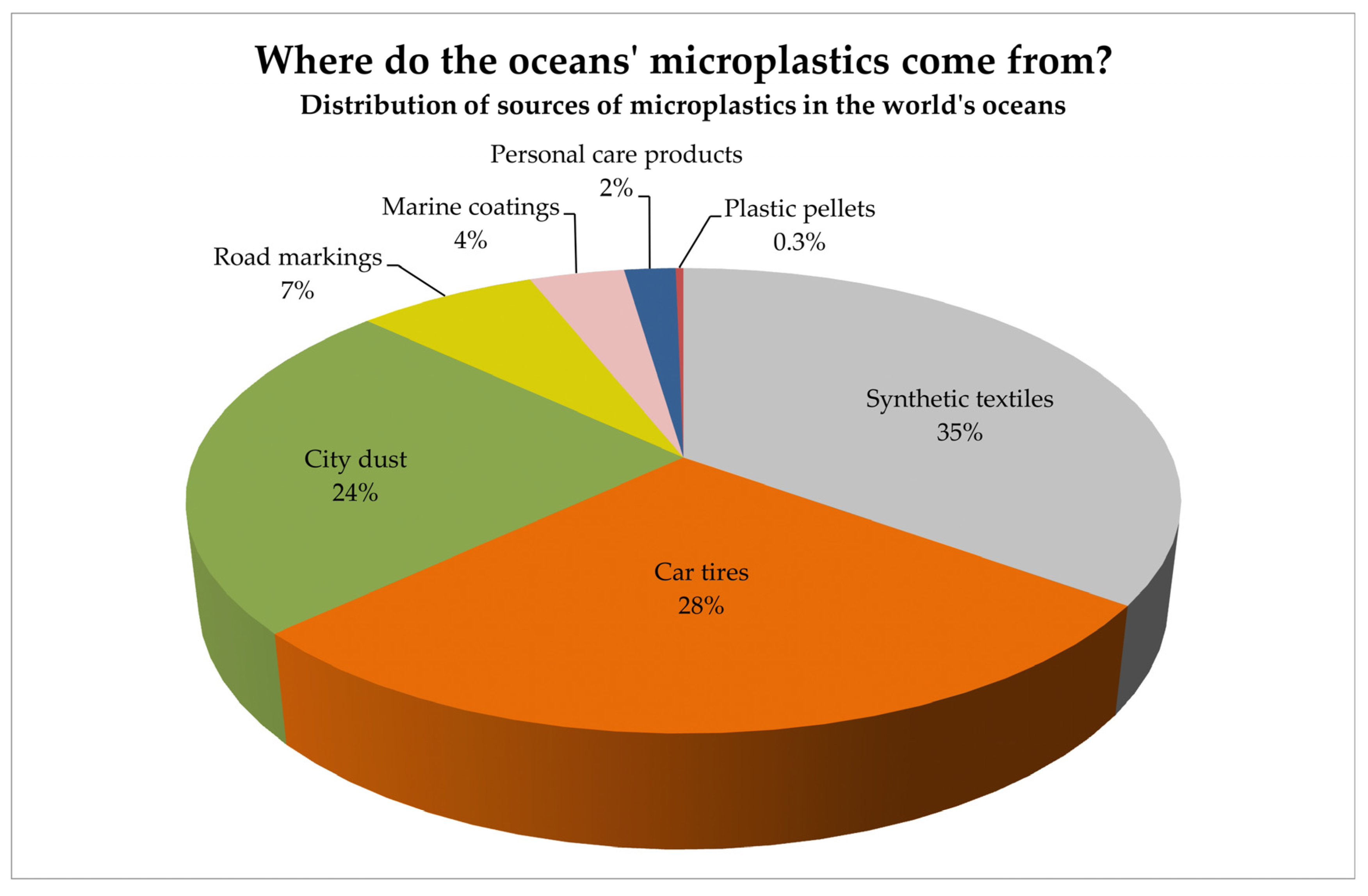
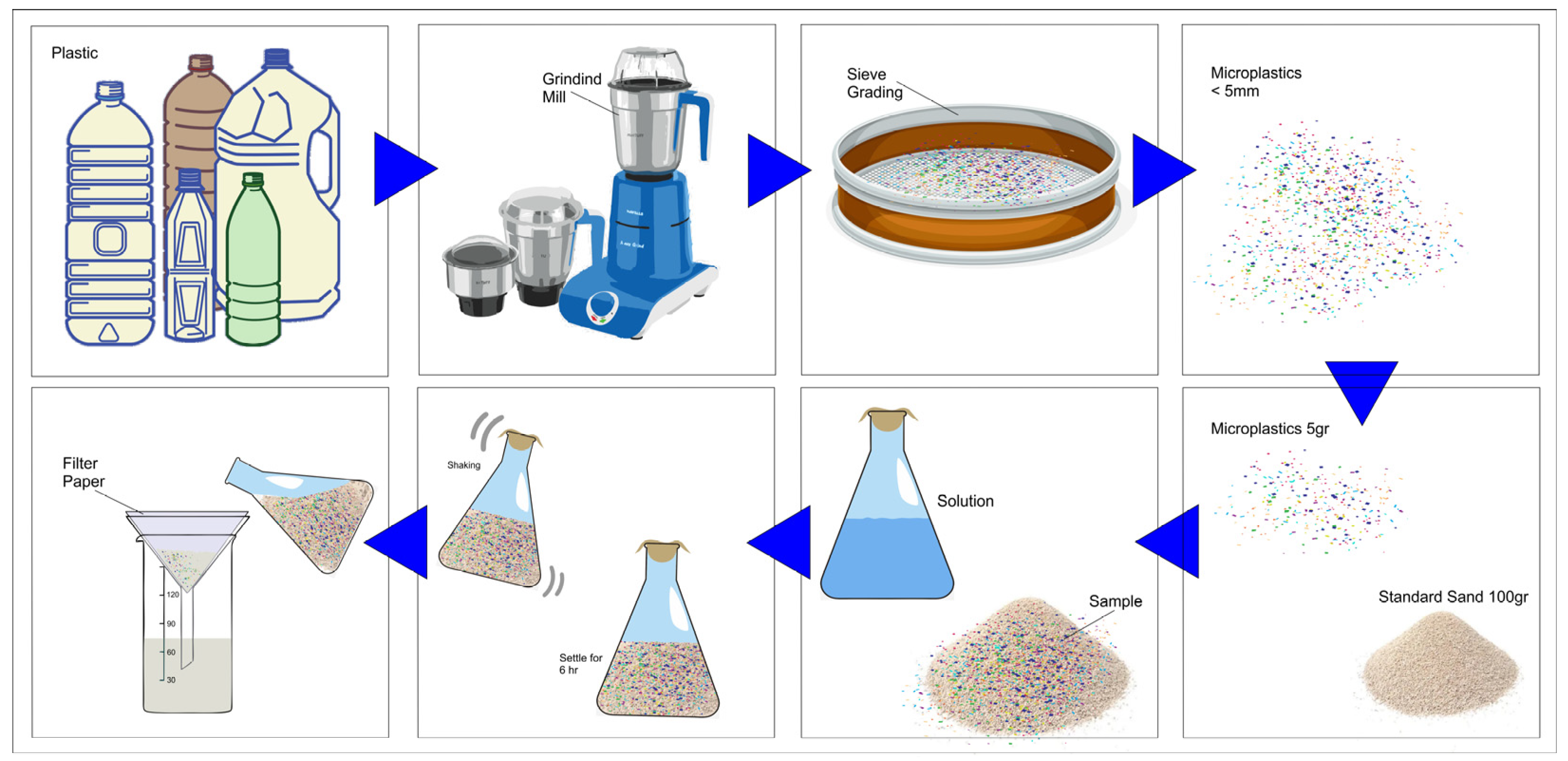
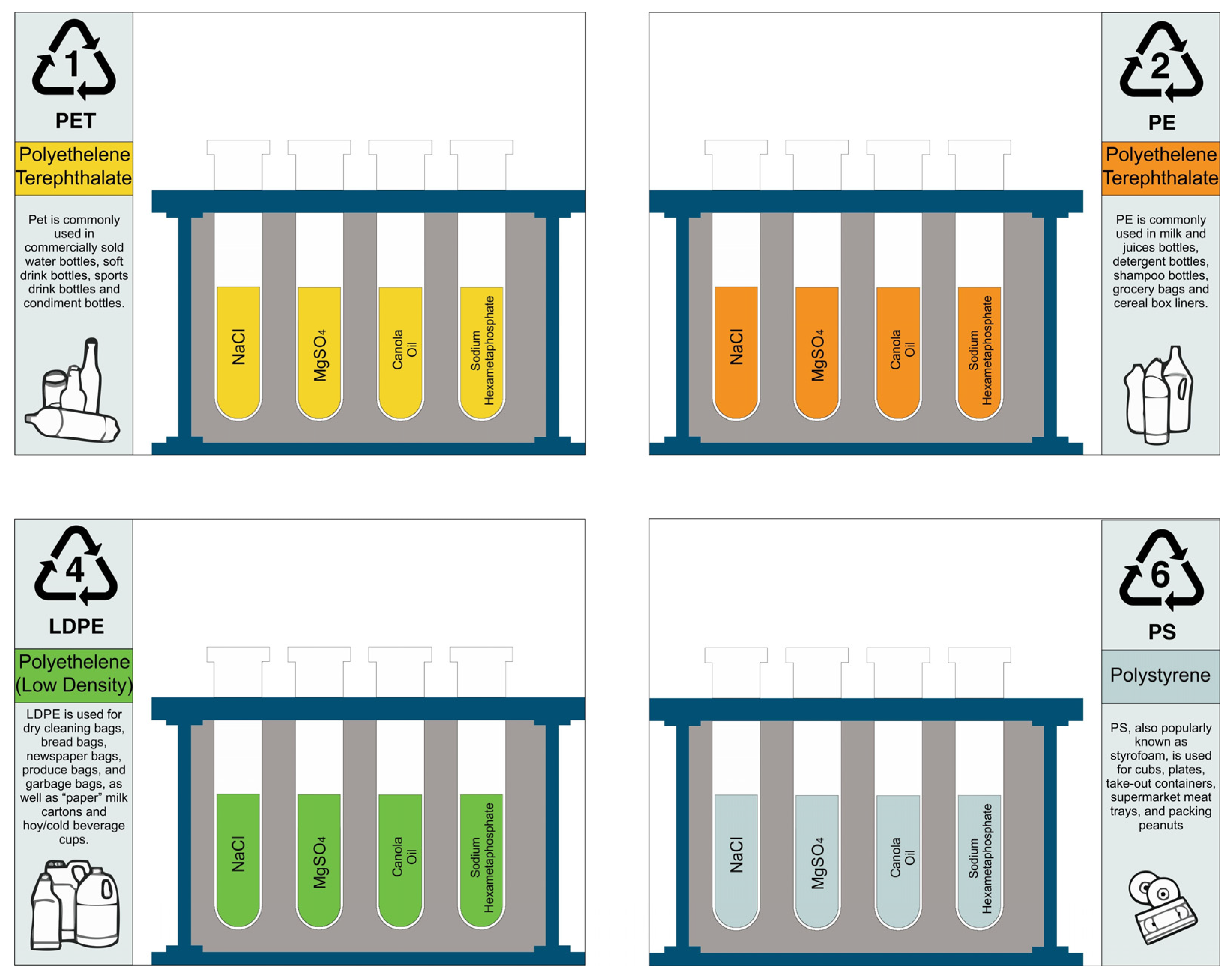
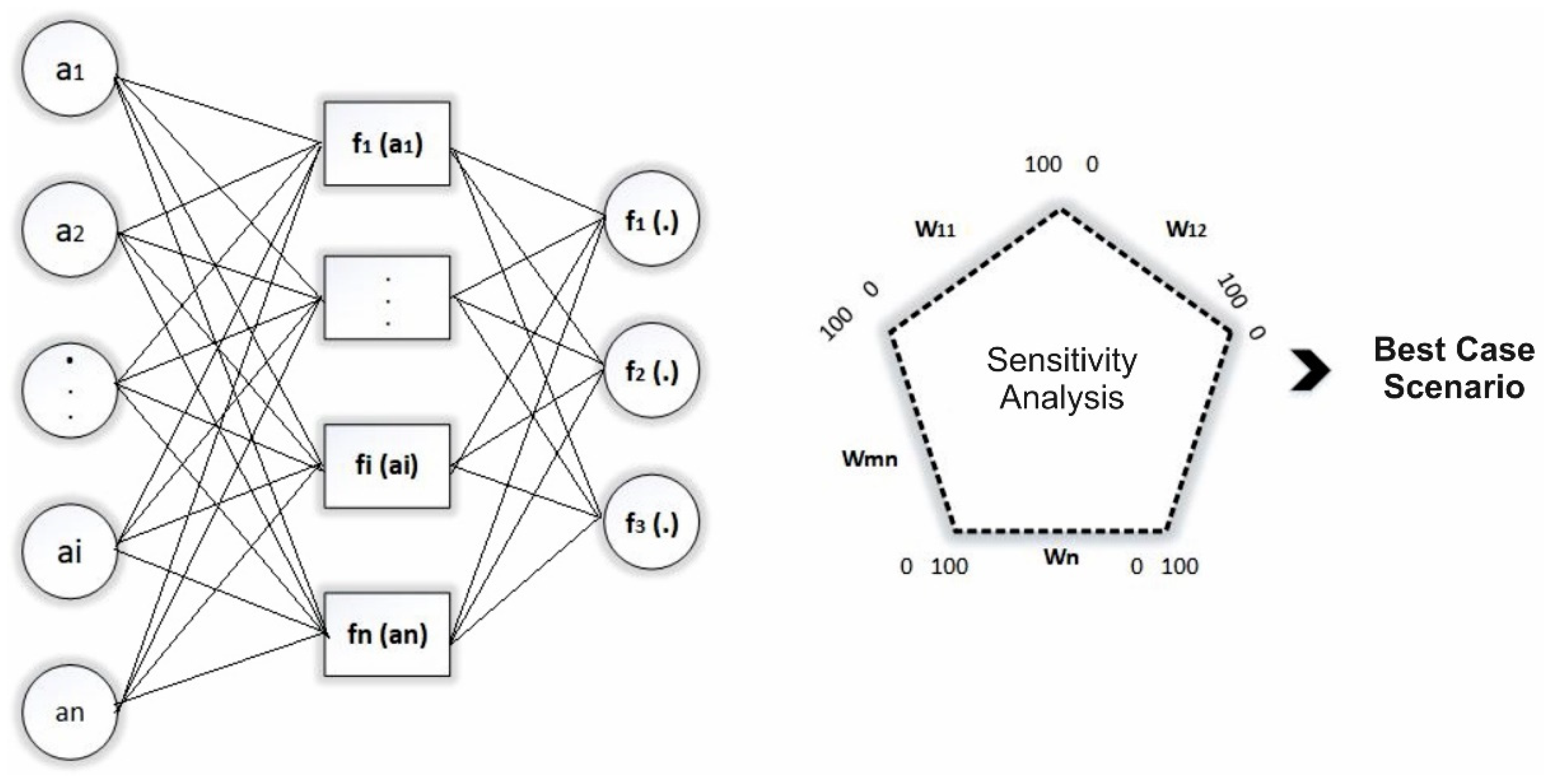


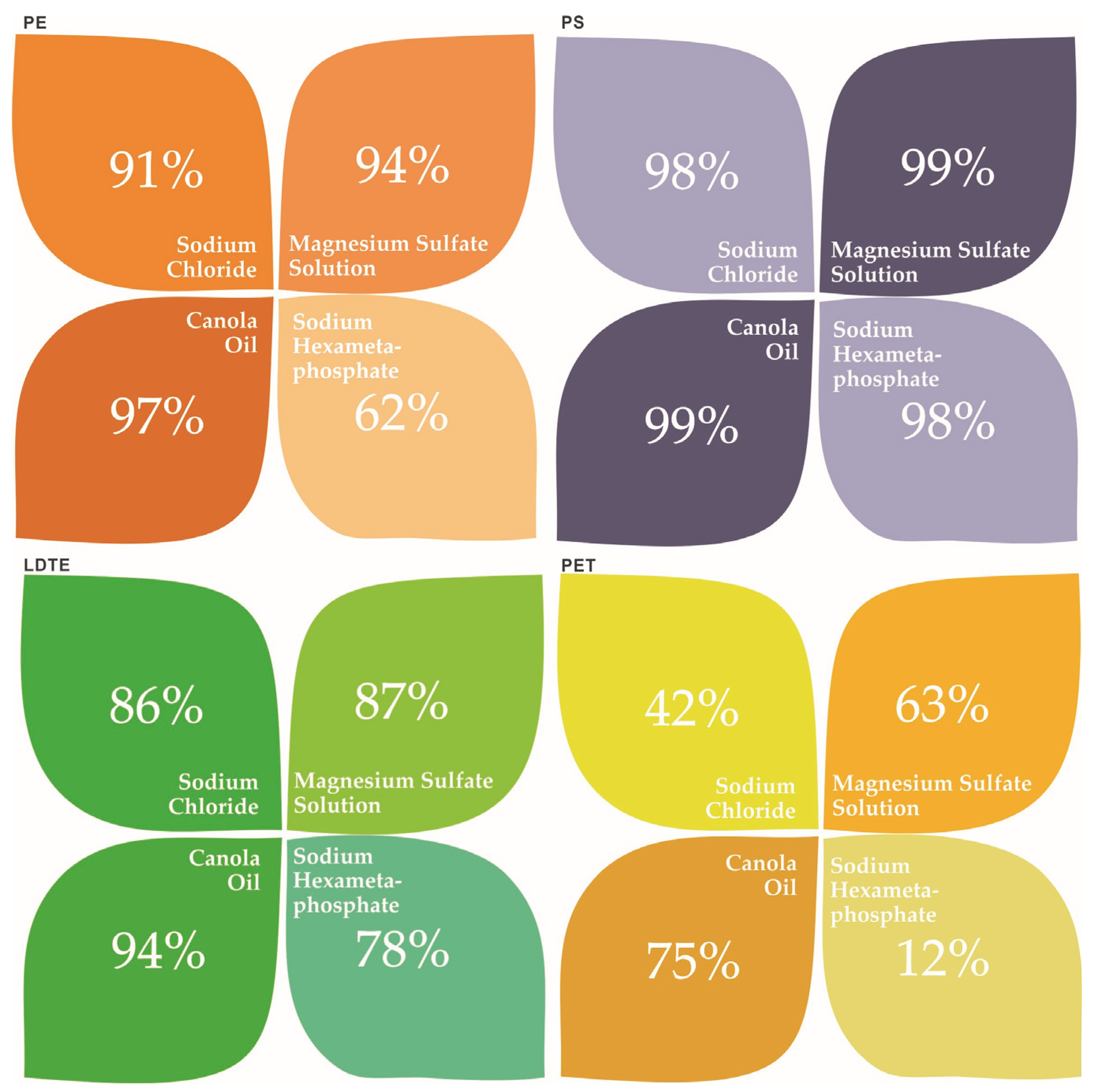
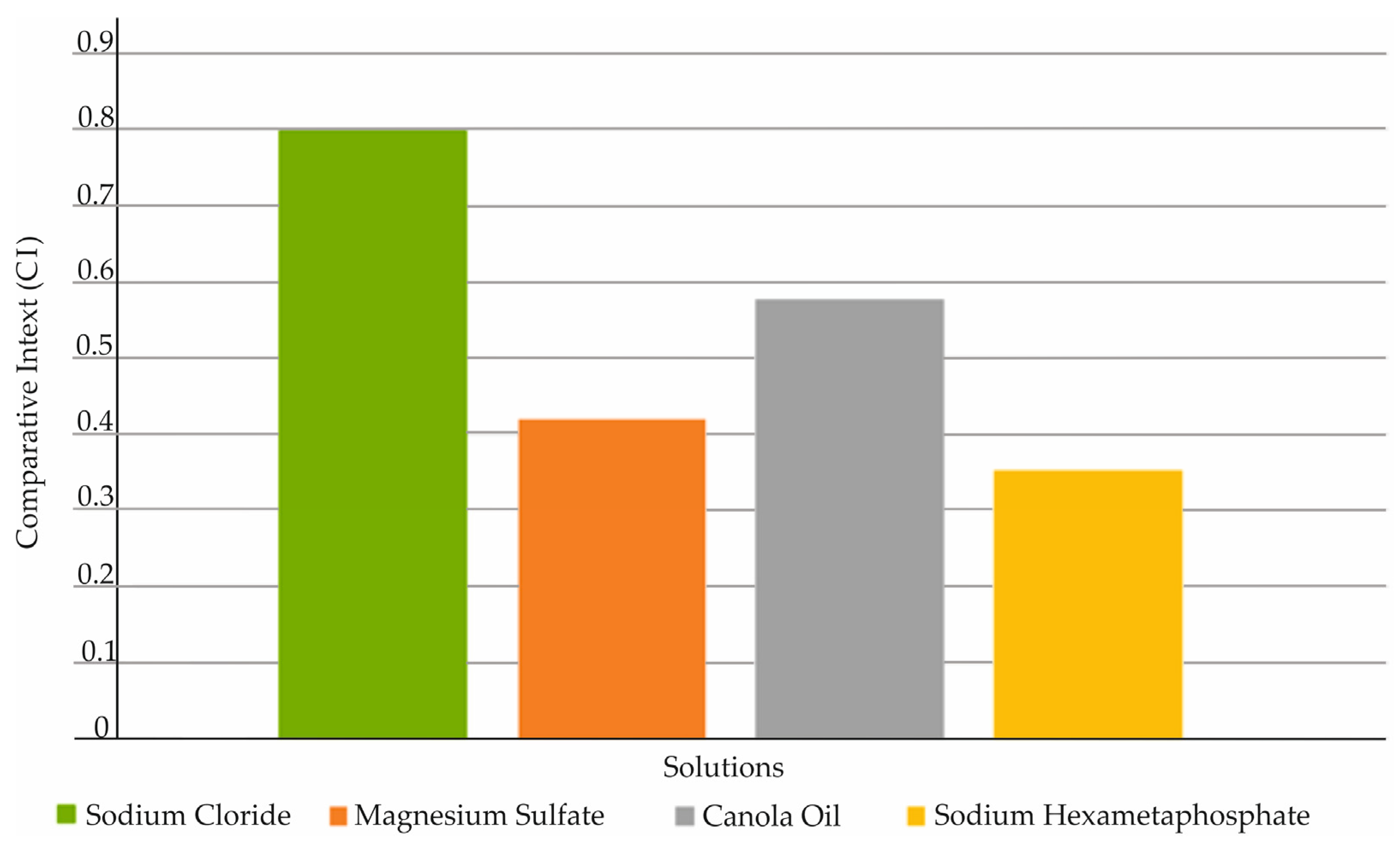
| Square Mesh Size (mm) | Cumulative Retained (%) |
| 0.08 | 99 ± 1 |
| 0.16 | 87 ± 5 |
| 0.50 | 67 ± 5 |
| 1.00 | 33 ± 5 |
| 1.60 | 7 ± 5 |
| 2.00 | 0 |
| Polymer | Density (g/cm−3) |
|---|---|
| PE | 0.95~0.97 |
| PS | 0.95~1.06 |
| LDPE | 0.89~0.93 |
| PET | 1.37~1.41 |
| Value | Definition | Interpretation |
|---|---|---|
| 1 | Equal Preference | Both criteria/scenarios contribute equally to the goal |
| 3 | Moderate Strong Preference | One criterion/scenario is slightly more important than the other |
| 5 | Strong Preference | One criterion/scenario is significantly more important than the other |
| 7 | Very Strong Preference | One criterion/scenario is very important compared to the other |
| 9 | Extremely Strong Preference | One criterion/scenario is extremely more important than the other |
| 2, 4, 6, 8 | Intermediate Preference Values | Used to express intermediate preferences |
| Average Recovery Performance (%) | ||||
|---|---|---|---|---|
| Type pf Polymer | Sodium Chloride Solution | Magnesium Sulfate Solution | Canola Oil | Sodium Hexametaphosphate |
| PE | 91 | 94 | 97 | 62 |
| PS | 98 | 99 | 99 | 98 |
| LDPE | 86 | 87 | 94 | 78 |
| PET | 42 | 63 | 75 | 12 |
| Criteria | |||||
|---|---|---|---|---|---|
| Economic Cost | Environmental Safety | Technical | |||
| Simplicity | Users’ Safety | Validity | |||
| Sodium Chloride | 9 | 8 | 8 | 8 | 7 |
| Magnesium Sulfate | 5 | 5 | 8 | 6 | 8 |
| Canola Oil | 7 | 4 | 8 | 7 | 9 |
| Sodium Hexametaphosphate | 4 | 7 | 8 | 8 | 4 |
Disclaimer/Publisher’s Note: The statements, opinions and data contained in all publications are solely those of the individual author(s) and contributor(s) and not of MDPI and/or the editor(s). MDPI and/or the editor(s) disclaim responsibility for any injury to people or property resulting from any ideas, methods, instructions or products referred to in the content. |
© 2024 by the authors. Licensee MDPI, Basel, Switzerland. This article is an open access article distributed under the terms and conditions of the Creative Commons Attribution (CC BY) license (https://creativecommons.org/licenses/by/4.0/).
Share and Cite
Phinikettou, V.; Papamichael, I.; Voukkali, I.; Zorpas, A.A. Comparison of Methodologies for Microplastic Isolation through Multicriteria Analysis (AHP). Microplastics 2024, 3, 184-204. https://doi.org/10.3390/microplastics3010011
Phinikettou V, Papamichael I, Voukkali I, Zorpas AA. Comparison of Methodologies for Microplastic Isolation through Multicriteria Analysis (AHP). Microplastics. 2024; 3(1):184-204. https://doi.org/10.3390/microplastics3010011
Chicago/Turabian StylePhinikettou, Valentina, Iliana Papamichael, Irene Voukkali, and Antonis A. Zorpas. 2024. "Comparison of Methodologies for Microplastic Isolation through Multicriteria Analysis (AHP)" Microplastics 3, no. 1: 184-204. https://doi.org/10.3390/microplastics3010011
APA StylePhinikettou, V., Papamichael, I., Voukkali, I., & Zorpas, A. A. (2024). Comparison of Methodologies for Microplastic Isolation through Multicriteria Analysis (AHP). Microplastics, 3(1), 184-204. https://doi.org/10.3390/microplastics3010011











